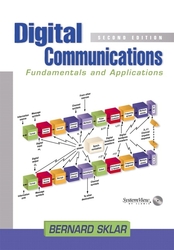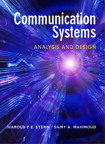Telecommunications Breakdown: Concepts of Communication Transmitted via Software-Defined Radio
暫譯: 電信崩潰:透過軟體定義無線電傳輸的通信概念
C. Richard Johnson, William A. Sethares
- 出版商: Prentice Hall
- 出版日期: 2003-09-02
- 售價: $960
- 語言: 英文
- 頁數: 400
- 裝訂: Paperback
- ISBN: 0131430475
- ISBN-13: 9780131430471
-
相關分類:
通訊系統 Communication-systems
已絕版
買這商品的人也買了...
-
 Modern Digital and Analog Communications Systems, 3/e
Modern Digital and Analog Communications Systems, 3/e$1,100$1,078 -
 C++ Primer, 3/e 中文版
C++ Primer, 3/e 中文版$980$774 -
 專業 XML 程式設計第二版 (Professional XML, 2/e)
專業 XML 程式設計第二版 (Professional XML, 2/e)$800$632 -
 C++ Builder 6 完全攻略
C++ Builder 6 完全攻略$690$587 -
 ASP.NET 程式設計徹底研究
ASP.NET 程式設計徹底研究$590$466 -
 Signal Processing First (IE-Paperback)
Signal Processing First (IE-Paperback)$1,190$1,166 -
 鳥哥的 Linux 私房菜-伺服器架設篇
鳥哥的 Linux 私房菜-伺服器架設篇$750$638 -
 鳥哥的 Linux 私房菜─基礎學習篇增訂版
鳥哥的 Linux 私房菜─基礎學習篇增訂版$560$476 -
 $1,078Machine Learning (IE-Paperback)
$1,078Machine Learning (IE-Paperback) -
 JSP 2.0 技術手冊
JSP 2.0 技術手冊$750$593 -
 電腦專業維修與進階測試
電腦專業維修與進階測試$390$308 -
 E-Project 創意網站經典
E-Project 創意網站經典$680$537 -
 嵌入式 C 語言 (Embedded C)
嵌入式 C 語言 (Embedded C)$450$356 -
 Linear Systems and Signals, 2/e (IE-Paperback)
Linear Systems and Signals, 2/e (IE-Paperback)$1,190$1,166 -
 Eclipse 整合開發工具 (Eclipse)
Eclipse 整合開發工具 (Eclipse)$540$427 -
 RFID 技術與應用
RFID 技術與應用$480$432 -
 Excel 2003 導引圖鑑
Excel 2003 導引圖鑑$450$356 -
 ASP.NET 徹底研究進階技巧─高階技巧與控制項實作
ASP.NET 徹底研究進階技巧─高階技巧與控制項實作$650$507 -
 PowerPoint 專業商務簡報大師
PowerPoint 專業商務簡報大師$380$300 -
 Linux iptables 技術實務─防火牆、頻寬管理、連線管制
Linux iptables 技術實務─防火牆、頻寬管理、連線管制$620$558 -
 Java 2 全方位學習(J2SE 5.0 增修版)
Java 2 全方位學習(J2SE 5.0 增修版)$750$593 -
 PHP 5 500個應用範例技巧大全集
PHP 5 500個應用範例技巧大全集$590$460 -
 ASP.NET 2.0 深度剖析範例集
ASP.NET 2.0 深度剖析範例集$650$507 -
 Ajax 快速上手 (Head Rush Ajax)
Ajax 快速上手 (Head Rush Ajax)$780$616 -
 聖殿祭司的 ASP.NET 2.0 專家技術手冊─使用 C#
聖殿祭司的 ASP.NET 2.0 專家技術手冊─使用 C#$720$569
商品描述
Summary
This book reflects the recent shift in telecommunications technology from hardware to software by focusing on the design of a digital software-defined radio. Telecommunications Breakdown helps readers build a complete digital radio that includes each part of a typical digital communication system. KEY TOPICS: By following each chapter, users create a Matlab realization of the various pieces of a typical digital communication system, exploring key ideas along the way. It defines the three steps in the creation of a working digital radio: building the pieces, assessing the performance of the pieces, and integrating the pieces together. In the final chapter, the reader “puts it all together” to build a fully functional receiver (not operational in real time). MARKET: For workers in the field of telecommunications.
Table of Contents
1. A Digital Radio.
2. A Telecommunication System.
3. The Five Elements.
4. Modeling Corruption.
5. Analog (De)Modulation.
6. Sampling with Automatic Gain Control.
7. Digital Filtering and the DFT.
8. Bits to Symbols to Signals.
9. Stuff Happens.
10. Carrier Recovery.
11. Pulse Shaping and Receive Filtering.
12. Timing Recovery.
13. Linear Equalization.
14. Coding.
15. Mix'n'Match® Receiver Design.
A. Transforms, Identities, and Formulas.
B. Simulating Noise.
C. Envelope of a Bandpass Signal.
D. Relating the Fourier Transform and the DFT.
E. Power Spectral Density.
F. Relating Difference Equations to Frequency Response and Intersymbol Interference.
G. Averages and Averaging.
商品描述(中文翻譯)
摘要
本書反映了電信技術從硬體轉向軟體的最新趨勢,專注於數位軟體定義無線電的設計。《電信崩潰》幫助讀者構建一個完整的數位無線電,涵蓋典型數位通信系統的每個部分。關鍵主題:透過每一章,使用者將創建一個 Matlab 實現,涵蓋典型數位通信系統的各個組件,並在過程中探索關鍵概念。它定義了創建一個可運作的數位無線電的三個步驟:構建組件、評估組件的性能,以及將組件整合在一起。在最後一章中,讀者將「將所有內容整合在一起」,以構建一個完全功能的接收器(不在實時操作中)。市場:針對電信領域的工作者。
目錄
1. 數位無線電。
2. 電信系統。
3. 五個元素。
4. 模擬失真。
5. 類比(去)調變。
6. 自動增益控制的取樣。
7. 數位濾波與離散傅立葉變換(DFT)。
8. 位元到符號到信號。
9. 事情發生。
10. 載波恢復。
11. 脈衝整形與接收濾波。
12. 時間恢復。
13. 線性均衡。
14. 編碼。
15. Mix'n'Match® 接收器設計。
A. 變換、恆等式與公式。
B. 模擬噪聲。
C. 帶通信號的包絡。
D. 將傅立葉變換與 DFT 相關聯。
E. 功率譜密度。
F. 將差分方程與頻率響應及符號間干擾相關聯。
G. 平均值與平均。










